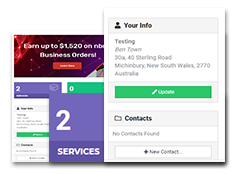Imagine you are meeting with an operations manager and finance director, pitching a cloud solution that will help the organisation to increase revenues by moving its data in an off premise storage and running its business systems in the cloud.
You start to provide benefits and case studies of how the cloud solution has helped other companies make more money per client.
The response from the operations manager is somewhat interested and the finance director is highly sceptical of your claims.
You thought that the value is noticeably clear and it all points to a rational decision to go with you, but they don’t and won’t – until you change your strategy.
Instead of highlighting what they can gain, highlight what they will lose.
You demonstrate case studies of their competitors who lost market share and then made a turnaround, fully recovering and more – thanks to your cloud solution that provided a multitude of benefits (increase in productivity, profitability, etc).
Since you have done your homework on the client, you start to point out the potential losses of not going ahead:
- Market share loss (provide a percentage approx.)
- Profitability per client (provide a loss per client percentage)
- Reputation in the market (brand equity percentage decline)
- Bottom line revenues (percentage reduction approx.)
- Potential personal damage to their reputation (reference company that had a bad experience)
- Bonuses (percentage decline)
- Total potential losses $XXX
As you start to highlight these painful losses, you’ll notice you have their attention and as long as you communicate it in a way they do not alienate them, you are on your way to rescuing the deal and potentially closing it.
A notable advantage to promoting what they stand to lose is that often you won’t have to reduce your fees/costs to close the deal, you don’t have to improve the deal, a lot of this comes down to understanding how to structure a deal and negotiating from a position of power. This is the power of the loss aversion effect.
So what just happened to get their attention? You’ve just experienced the “Loss Aversion Effect”, a phenomenon that emerges when fear of loss is more powerful than the anticipation of gain. Imagine you’re offered an opportunity on the toss of a coin. Heads, you win $150. Tails, you lose $100. Most people wouldn’t take this gamble because the fear of loss is more powerful than gaining $150 – the power of the loss aversion effect.
Suppose you woke up one day, which scenario would make you unhappier?
Example one: You check your wallet and wonder where you could have lost that $100.
Example two: You check your wallet and wonder where you could have lost that $50. The next day you lose another $50.
As you can see the examples are similar, as you are losing $100 at the end of the day. However, an interesting insight is that most people would prefer not accumulating losses as it is perceived as more painful.
So why is the fear of loss so much more powerful than the motivation to gain a reward, even when the reward is higher? A lot of it comes down to our inborn instinct to avoid risk and pain. The hunter-gatherer that took risks didn’t last long. Cautious hunter-gatherers who did not take unnecessary risks survived … and here we all are as a result!
One strategy to consider is to collate all the potential losses in one figure as a lump sum. Now you have their attention. Our response to fear has never left us, our primal brains still overreact to fear of loss. This overreaction in the brain prevents us from thinking straight. A client will generally have to think a little bit longer about what they will gain from your proposal, but they will understand what they stand to lose far more quickly. It’s as if they can’t help themselves. But the loss aversion effect works both ways: you can also use it to control a prospect’s attention.
To influence clients, especially resistant clients in the current environment a suggested strategy is to offer many options for a trial period. The client will become used to all these and when the trial finishes, they will want to keep the options and be willing to pay a bit more to have them. This is one of the reasons why subscription services that focus on up-selling after the initial period not only increase profitability per client but also loyalty.
Important note: Remember to highlight their losses if they do go to the base rate.
Many people have experienced loss due to this pandemic, and not only just money. When we lose something the pain we feel psychologically, is similar to physical pain.
People have lost:
- Freedom
- Connection to people
- Opportunity
- Jobs
- Plans
- Future
- Relationships
Do you think they want to lose more?
As salespeople, we are inherently focused on solving problems and are taught that if you tell the client what they will gain they will be easier to close. Unfortunately, the brain does not work that way!
The takeaway for salespeople: when presenting, show how your solution will prevent losses, then present what a prospect stands to gain.
In negotiation, this is called framing. You must frame your numbers in a way that the client understands the potential loss more than the potential gain, especially when summarising.
Remember also that more audience attention will be devoted to evaluating information about potential losses than information about the potential gains. This happens even when the gain is pretty much the same as the loss, especially when competitors are offering similar benefits.
It also means that when presenting your proposal against a competitor, telling your prospect company what the competitor does not provide is powerful – you’re telling them what they might lose! Be aware that how you present information will impact on how you influence the perception, which is where you win deals.
Free resource:
Click here to download the Weekly Focus Activity. This short, weekly activity will help you to create and maintain razor sharp focus. The first step to achieving your goals – fast!
About the author

Pancho brings considerable experience, gained over 30+ years’ of corporate sales success, knowledge of the psychology of top sales performers and ongoing collaboration with leading Australian and international behavioural and clinical psychologists, that allows business and sales executives to reach their full potential.
He authors a host of training, mentoring and development programmes online and in person as well as speaking professionally on the psychology in selling and optimum sales performance, both in Australia and internationally.
To know more about visit: https://frontierp.com.au/
 Contact us
Contact us  Partner Login
Partner Login  Service Status
Service Status 


 November 24, 2022
November 24, 2022
 Pancho Mehrotra
Pancho Mehrotra
 3 mins
3 mins